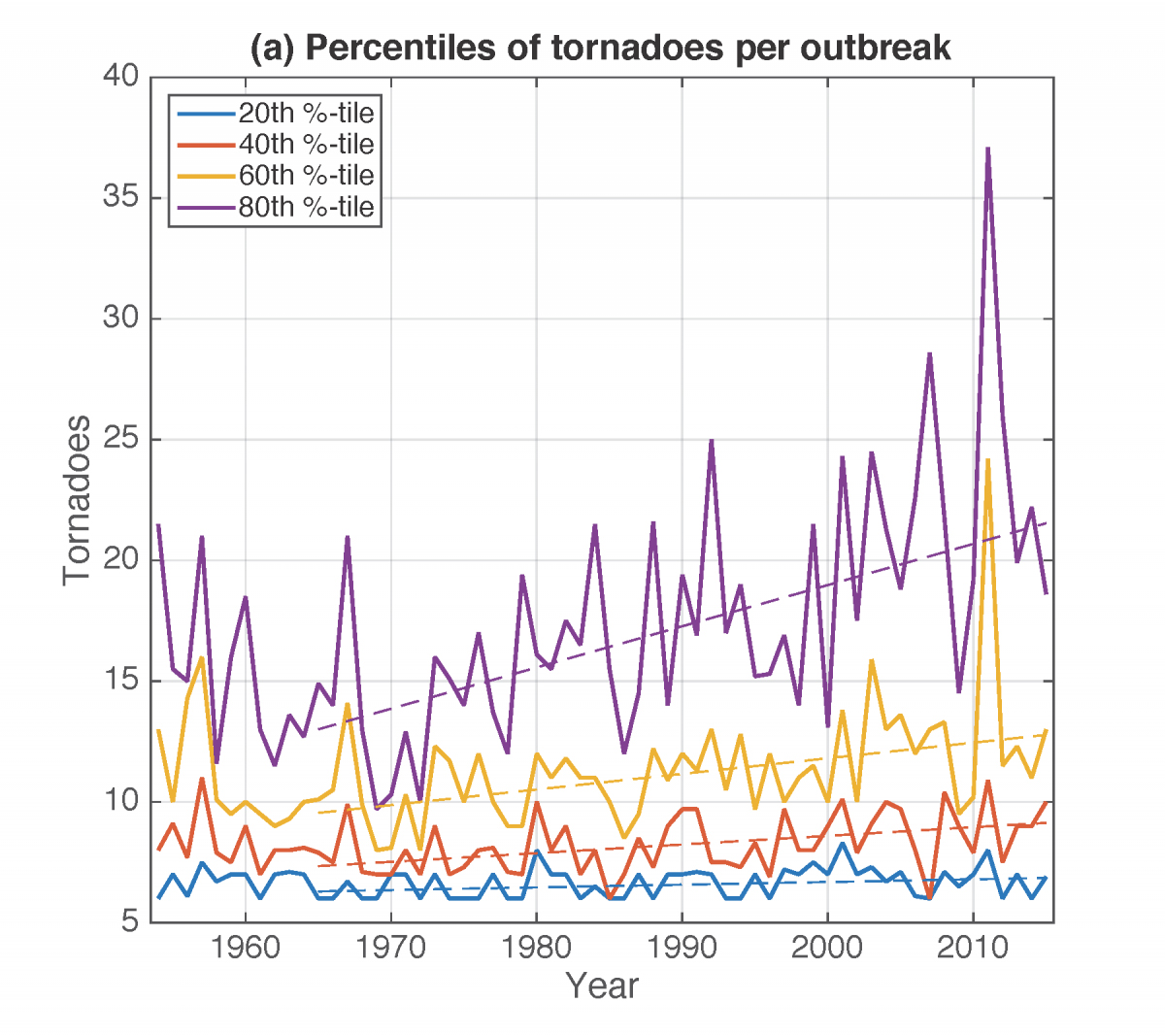
Researchers are examining a link between climate change and an increase in tornado outbreaks.
New research is being conducted to help correlate how climate change has impacted outbreaks of tornadoes.
Michael Tippett, Ph.D., an associate professor of applied physics and applied mathematics at Columbia University, recently published a study showing that the average number of tornadoes—large-scale weather events that can last one to three days and span huge regions—has risen since 1954.
With a better understanding on how climate affects tornado activity researchers may be able to better predict tornado activity in the short-term, a month or even a year in advance and would be able to aid to insurance and reinsurance companies in assessing the risks posed by outbreaks.
“An assessment of changing tornado outbreak size is highly relevant to the insurance industry,” Kelly Hereid, AVP, Senior Research Scientist, Chubb Tempest Re, said in a statement.
“Common insurance risk management tools like reinsurance and catastrophe bonds are often structured around storm outbreaks rather than individual tornadoes, so an increasing concentration of tornadoes into larger outbreaks provides a mechanism to change loss potential without necessarily altering the underlying tornado count. This approach provides an expanded view of disaster potential beyond simple changes in event frequency.”
Tippett and a team of researchers examined data on increasing trends in the severity of tornado outbreaks where they measured severity by the number of tornadoes per outbreak. They were able to ascertain that these trends are increasing fastest for the most extreme outbreaks.
“This study raises new questions about what climate change will do to severe thunderstorms and what is responsible for recent trends,” Tippett, who is also a member of the Data Science Institute and the Columbia Initiative on Extreme Weather and Climate, said in a statement.
“The fact that we don’t see the presently understood meteorological signature of global warming in changing outbreak statistics leaves two possibilities: either the recent increases are not due to a warming climate or a warming climate has implications for tornado activity that we don’t understand. This is an unexpected finding.”
The researchers examined two National Oceanic and Atmospheric Administration datasets containing tornado reports and other observation-based estimates of meteorological quantities associated with tornado outbreaks.
“Other researchers have focused on tornado reports without considering the meteorological environments,” Chiara Lepore, associate research scientist at the Lamont-Doherty Earth Observatory, who is a coauthor of the paper, said in a statement. “The meteorological data provide an independent check on the tornado reports and lets us check for what would be expected under climate change.”
According to NOAA statistics, there were 888 total tornadoes in 2014 that resulted in 47 deaths.
There has been a push in recent decades for scientists to examine U.S. tornado activity and despite no significant trends being derived from the number of reliably reported tornadoes or of outbreaks, recent studies indicate increased variability in large normalized economic and insured losses from U.S. thunderstorms.
There were also increases in the annual number of days on which many tornadoes occur and increases in the annual mean and variance of the number of tornadoes per outbreak.
In Tippett’s study they used extreme value analysis and found that the frequency of outbreaks with many tornadoes is increasing and increasing faster for more extreme outbreaks. The research group modeled this behavior using extreme value distributions with parameters that vary to match the trends in the data.
There have been consistent upward trends in extreme meteorological environments associated with severe thunderstorms. However, the trends did not resemble those currently expected to result from climate change.
The researchers looked at convective available potential energy (CAPE) and a measure of vertical wind shear, storm relative helicity. While the modeling studies have projected that CAPE will increase in a warmer climate leading to more frequent environments favorable to severe thunderstorms in the U.S., the meteorological trends were not due to increasing CAPE but rather due to trends in storm relative helicity, which has not been projected to increase under climate change.
“Tornadoes blow people away and their houses and cars and a lot else,” Joel Cohen, coauthor of the paper and director of the Laboratory of Populations, said in a statement. “We’ve used new statistical tools that haven’t been used before to put tornadoes under the microscope.
“We found that, over the last half century or so, the more extreme the tornado outbreaks, the faster the numbers of such extreme outbreaks have been increasing. What’s pushing this rise in extreme outbreaks is far from obvious in the present state of climate science. Viewing the thousands of tornadoes that have been reliably recorded in the U.S. over the past half century or so as a population has permitted us to ask new questions and discover new, important changes in outbreaks of these tornadoes.”
According to Tippett, more studies are needed to attribute the observed change to either global warming or another component of climate variability. A study by the same research group has already been planned to examine other aspects of severe thunderstorms—including hail—which cause less intense damage but is important for business because it affects larger areas and is responsible for substantial losses every year.
The study, which was published in Science, can be viewed here.

Annual 20th, 40th, 60th and 80th percentiles of the number of E/F1+ tornadoes per outbreak (6 or more E/F1+ tornadoes), 1954-2015 (solid lines), and quantile regression fits to 1965-2015 assuming linear growth in time (dashed lines). (Credit: Michael Tippett)




